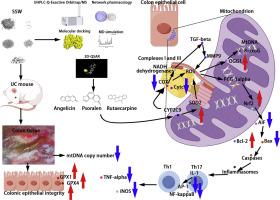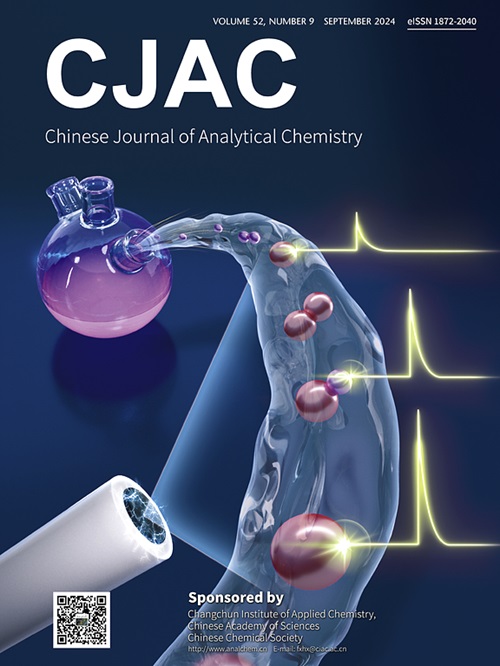四神丸的主要活性成分可能通过减轻葡聚糖硫酸钠诱导的溃疡性结肠炎中氧化应激引起的线粒体损伤来调节T细胞相关的促炎细胞因子
IF 1.3
4区 化学
Q4 CHEMISTRY, ANALYTICAL
引用次数: 0
摘要
四神丸(SSW)是一种治疗溃疡性结肠炎(UC)的经典中药汤剂,但其主要活性成分对线粒体与T细胞相互作用的分子机制尚不清楚。本研究旨在确定SSW的主要活性成分,预测并探讨SSW主要活性成分在UC发育过程中调节线粒体功能、改善线粒体损伤,进而调节T细胞平衡的可能调控机制。方法采用荧光定量法和实时荧光定量聚合酶链反应(qRT-PCR)评价SSW对UC炎症损伤的疗效,并初步探讨SSW抗氧化应激的作用机制。通过网络药理学、分子对接、动态模拟、三维定量构效关系(3D-QSAR)等方法预测主要活性成分及其可能的配体。通过RNA-seq分析和western blot (WB)分析SSW对遗传谱变化的影响,发现并预测所选生物活性化合物抗线粒体损伤和促炎t细胞的潜力。结果sssw能有效改善葡聚糖硫酸钠(DSS)所致UC的结肠损伤,减轻氧化应激。从SSW中提取的Angelicin、corylifolinin、补骨脂素和rutaecarpine是SSW的主要成分,由于其结合能最低,可能与CYP2C9和CYP1A1相互作用。根据RNA-seq数据,SSW通过调节线粒体功能和T细胞反应相关基因来缓解UC。在SSW干预下,细胞相关靶点和T细胞相关促炎细胞因子下调,而mtDNA修复相关靶点上调。此外,caspase、炎性小体以及Th1和Th17极化相关基因分别与细胞色素C氧化酶(COX)、caspase和炎性小体相关基因呈正相关。综上所述,本研究不仅确定了SSW的主要生物活性成分及其可能的配体,还提供了当归素、石竹脂素、补骨脂素和芦果卡果素可能减轻氧化应激和线粒体损伤,进而调节Th1和th17相关的促炎细胞因子。本文章由计算机程序翻译,如有差异,请以英文原文为准。

Main active components of Sishen Wan may modulate T cells-related proinflammatory cytokines via alleviating mitochondrial damage caused by oxidative stress in dextran sulphate sodium-induced ulcerative colitis
Introduction
Sishen Wan (SSW), a classical traditional Chinese medicine decoction, is described to treat ulcerative colitis (UC) patients, but the molecular mechanisms of the main active ingredients of SSW on the interaction between mitochondria and T cells are still unclear. This study aimed to determine the main active ingredients of SSW, predict and explore the possible regulatory mechanism of main active ingredients of SSW in modulating mitochondrial function and ameliorating mitochondrial damage, followed by regulating T cell balance during UC development.
Methods
Colorimetric test and quantitative real-time polymerase chain reaction (qRT-PCR) were performed to evaluate the efficacy of SSW on inflammatory injuries of UC and preliminarily explore the mechanisms of SSW against oxidative stress. The main active components and their possible ligands were predicted by network pharmacology, molecular docking, dynamic simulation and three-dimensional-quantitative structure activity relationship (3D-QSAR). RNA-seq analysis and western blot (WB) was conduct to discover the impact of SSW on genetic profile changes, and discover and predict the potentials of anti-mitochondrial damage and proinflammatory T-cells of the selected bioactive compounds.
Results
SSW effectively ameliorated the colonic injuries and alleviated the oxidative stress in the dextran sulphate sodium (DSS)-induced UC. Angelicin, corylifolinin, psoralen and rutaecarpine, derived from SSW, were identified as the main components of SSW, and might interact with CYP2C9 and CYP1A1 due to the lowest binding energy. SSW alleviated UC via regulating genes related to mitochondrial function and T cell responses based on RNA-seq data. Cytc-related targets and T cell-associated proinflammatory cytokines were downregulated, while mtDNA repairing-related targets were upregulated with SSW intervention. Moreover, the caspase, inflammasome and Th1 and Th17 polarizing-related genes are positively correlated with cytochrome C oxidase (COX), caspase and inflammasome-associated genes, respectively.
Conclusion
Taken together, this study not only identifies the main bioactive ingredients of SSW and their possible ligands, but also provides angelicin, corylifolinin, psoralen and rutaecarpine may alleviate oxidative stress and mitochondrial damage, followed by modulating Th1 and Th17-related proinflammatory cytokines.
求助全文
通过发布文献求助,成功后即可免费获取论文全文。
去求助
来源期刊
CiteScore
3.60
自引率
25.00%
发文量
17223
审稿时长
35 days
期刊介绍:
Chinese Journal of Analytical Chemistry(CJAC) is an academic journal of analytical chemistry established in 1972 and sponsored by the Chinese Chemical Society and Changchun Institute of Applied Chemistry, Chinese Academy of Sciences. Its objectives are to report the original scientific research achievements and review the recent development of analytical chemistry in all areas. The journal sets up 5 columns including Research Papers, Research Notes, Experimental Technique and Instrument, Review and Progress and Summary Accounts. The journal published monthly in Chinese language. A detailed abstract, keywords and the titles of figures and tables are provided in English, except column of Summary Accounts. Prof. Wang Erkang, an outstanding analytical chemist, academician of Chinese Academy of Sciences & Third World Academy of Sciences, holds the post of the Editor-in-chief.

 求助内容:
求助内容: 应助结果提醒方式:
应助结果提醒方式:


